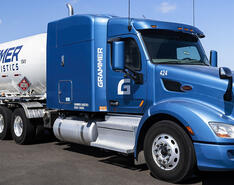Agility Fuel Solutions and Hexagon Mobile Pipeline have joined forces as Hexagon Agility, strengthening their position as a provider of (renewable) natural gas mobility solutions (g-mobility solutions). The combined business launched its new corporate identity and brand February 16.
In a press release dated February 15, the Missouri Propane Education and Research Council (MOPERC) invited the public to “Thank a propane delivery worker.”
With the continued cold weather blasting Missouri and much of the country, the organization explained, the state’s propane providers have been stepping up to ensure timely and safe deliveries to homes, farms and businesses.
According to the latest Baker Hughes Rig Count, released February 12, the United States rig count was up five from the previous week to 397. Oil rigs were up seven to 306, gas rigs were down two to 90, and miscellaneous rigs were unchanged at one.
The U.S. rig count was down 393 rigs from last year’s count of 790, with oil rigs down 372, gas rigs down 20 and miscellaneous rigs down one.
The U.S. offshore rig count was up one to 17, but down six year over year.
Livonia Public Schools added 22 Blue Bird propane autogas-fueled buses to its fleet with funding received from the Michigan Department of Environment, Great Lakes, and Energy (EGLE). The district was granted $844,386.40 through EGLE’s Fuel Transformation Program to purchase clean, cost-effective propane school buses that began operation when Michigan schools opened for the 2020-21 school year.
While the global oil and gas industry witnessed a marginal decrease in the number of contracts, from 1,283 in Q3 2020 to 1,145 in Q4, there was an almost 28% increase in terms of value from $17.58 billion to $22.55 billion.
United States exports of propane have been increasing in recent months, primarily to countries in East Asia, as a result of cold weather and robust petrochemical feedstock consumption that drive demand in that region, the Energy Information Administration (EIA) reported Feb. 9. Between April 2020 and November 2020 (the most recent monthly data in EIA’s Petroleum Supply Monthly), approximately 58% of all U.S. propane exports went to markets in Asia. Nearly half of all U.S.
DCP Midstream (Denver, Colorado) announced February 3 it has joined The Environmental Partnership, a growing coalition of companies in the United States oil and natural gas industry committed to continuously improving the industry’s environmental performance by taking action in operations; building upon their knowledge; and fostering collaboration.
The United States will likely take years to return to 2019 levels of energy consumption and carbon dioxide emissions following the impact of COVID-19 on the U.S. economy and global energy sector, according to projections in the U.S. Energy Information Administration’s (EIA) Annual Energy Outlook 2021 (AEO2021), which was released February 3.
The Advanced Clean Transportation (ACT) Expo will be returning to Long Beach, California, August 30 through September 2, offering the latest technologies, fuels, and policies driving economic and environmental sustainability affecting numerous transportation sectors.
According to the latest Baker Hughes Rig Count, released February 5, the United States rig count was up eight from the previous week to 392. Oil rigs were up four to 299, gas rigs were up four to 92, and miscellaneous rigs were unchanged at one.
The U.S. rig count was down 398 rigs from last year's count of 790. Oil rigs were down 377, gas rigs were down 19, and miscellaneous rigs were down two.
The U.S. offshore rig count was unchanged at 16, down seven year over year.
America’s oilfield services and equipment sector (OFS) employment rose by an estimated 8,421 jobs in January, a fifth consecutive month of growth, according to preliminary data from the Bureau of Labor Statistics (BLS) and analysis by the Energy Workforce & Technology Council (Council).
Swanson Russell received 15 awards at the 2021 Public Relations Society of America (PRSA) Nebraska Paper Anvil Awards Gala held virtually on January 28. Three of the awards honored the firm’s work with the Propane Education & Research Council (PERC).
PRSA Nebraska’s Paper Anvil Awards honor outstanding contributions made to the public relations profession. The competition recognizes organizations that have successfully addressed a communications challenge with skill, creativity, and resourcefulness.
ThompsonGas (Frederick, Md.) announced Jan. 28 the acquisition of All Service Propane Inc. (Anderson, Calif.), a propane provider in Northern California. ThompsonGas reports it is committed to serving the residential, commercial and agricultural customers who have valued the All Service Propane presence and service in the area for multiple decades.
To help pair employers with job seekers in the Mid-States region, a new job-listing website is now available called Propane Connect. This new site is free to use for graduating students and experienced workers seeking employment within the propane industry.
Blue Peak Resources, a Florida-based merger and acquisitions consulting firm, announced February 2 the sale of Malzahn Gas Service.
The number of drilled but uncompleted wells (DUCs) that accumulated at the height of the pandemic has already subsided to pre-COVID-19 levels in the United States, a Rystad Energy analysis announced Jan. 25 shows. After swelling to a multi-year high of 6,548 wells in June 2020, the number of such wells in the country’s major oil regions slimmed down to around 5,700 wells by the end of December 2020.
In the latest Baker Hughes Rig Count, released Jan. 29, the United States rig count was up six from the previous week to 384. Oil rigs were up six to 295, gas rigs were unchanged at 88, and miscellaneous rigs were unchanged at one.
The U.S. rig count was down 406 rigs from last year’s count of 790, with oil rigs down 380, gas rigs down 24, and miscellaneous rigs down two.
The U.S. offshore rig count was unchanged at 16, down five year over year.
Founded in 1924, and located in Peabody, Mass., Holden is an established independent retail energy distributor serving approximately 8750 residential and commercial customers in the Northeast.

